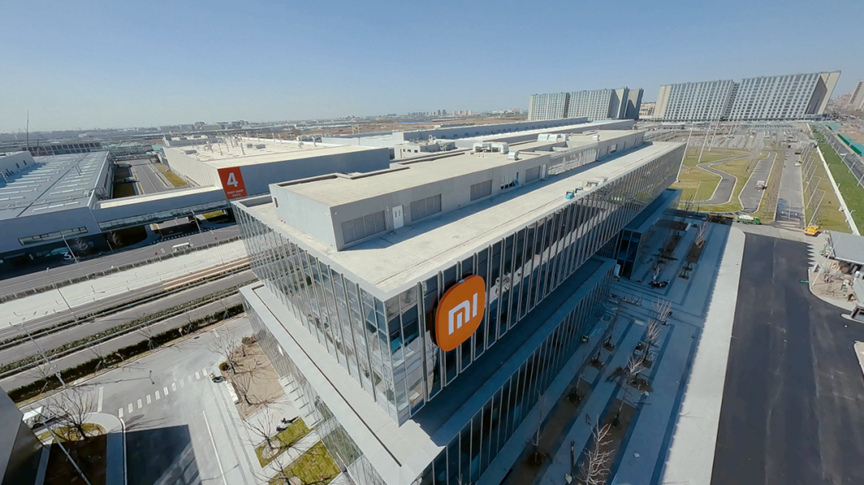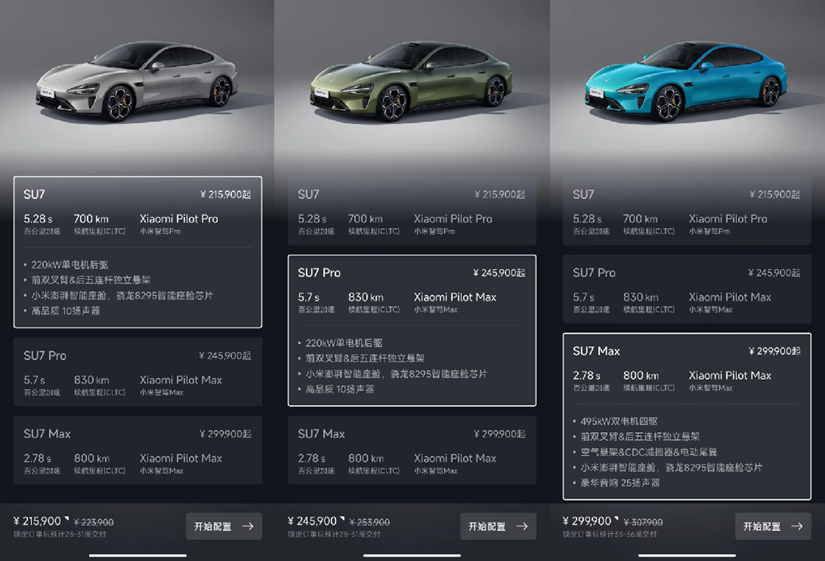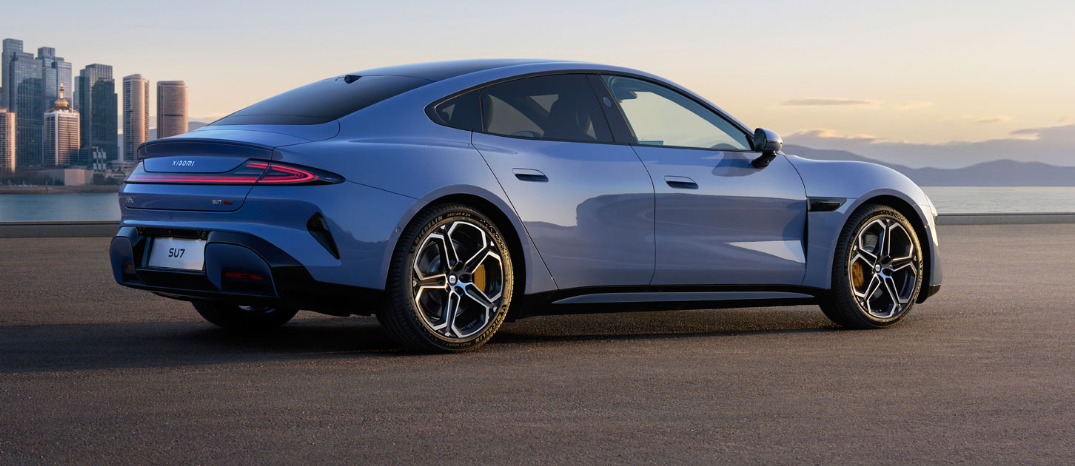On October 29 this year, Xiaomi held a product launch event in Beijing, introducing a range of new products, including HyperOS 2 and the mass-produced unit of the Xiaomi SU7 Ultra model.
The Xiaomi SU7 Ultra is the world's first car model to feature the CATL Qilin 2.0 battery, with a pre-sale price of 814,900 yuan. Reservations are now open, and the official launch is set for March next year.
Making big splash with a single car model
On July 19, Mr. Lei Jun, Founder, Chairman, and CEO of Xiaomi, delivered an annual speech themed Courage, reviewing the story behind Xiaomi's car manufacturing journey.
In today's competitive new energy vehicle market, it is not easy for a new car to stand out. However, Xiaomi's first car model, the Xiaomi SU7, became a market hit upon its debut.

Xiaomi SU7; photo credit: Xiaomi EV
After announcing its carmaking plan in 2021, Xiaomi officially put the SU7 model onto the market, with the pre-orders topping 10,000 units within 4 minutes and 50,000 within 27 minutes. The SU7's monthly deliveries reached over 7,000 units in April, 8,630 units in May, and exceeded 10,000 units in June, far surpassing industry expectations.
Hi, welcome to Gasgoo. In this episode of "Wheels of Change: Stories of Chinese Auto Giants," let's talk about Xiaomi.
The origin of the Xiaomi brand dates back to 2010. At that time, smartphones were gradually replacing traditional phones as the new favorable communication tool. The Chinese phone market was dominated either by high-end foreign brands or flooded with counterfeit devices. Consumers were becoming more sensitive to the performance and price of mobile devices, and there was a growing demand for high-performance, cost-effective smartphones. Xiaomi emerged in response to this demand.
With its high cost performance and powerful marketing strategies, Xiaomi's smartphone sales have been continuously rising. By 2014, Xiaomi's annual smartphone sales had exceeded 60 million units, with revenue surpassing $10 billion. It ranked first by sales in China and third globally. On July 9, 2018, when Xiaomi was listed on the Hong Kong Stock Exchange, its market value reached 370 billion HKD and surpassed 800 billion HKD by the end of 2020.
On January 14, 2021, Xiaomi, which was riding high, faced U.S. sanctions. The U.S. Department of Defense added Xiaomi to the "Chinese military companies" blacklist, requiring U.S. investors to divest their shares in Xiaomi by November 11, 2021.
At this crossroads, Xiaomi need to make a significant decision: if it could no longer produce smartphones, what would happen to its thousands of employees? At this time, the new field of smart electric vehicles caught Lei Jun's attention. After over 70 days of intense research, on March 30, 2021, Lei Jun officially announced that Xiaomi would make foray into the car manufacturing domain. He declared that this would be his last major entrepreneurial venture and was willing to stake his entire reputation to fight for Xiaomi's success in the automobile industry.

Xiaomi's founder, chairman, CEO Lei Jun; photo credit: Xiaomi EV
Although the U.S. lifted its sanctions on Xiaomi in May 2021, Xiaomi's carmaking plans did not stop. The group announced a full investment of 10 billion USD to support its car manufacturing business.
Lei Jun revealed that at the start of the car building venture, several venture capital firms named their prices for Xiaomi's automotive division. Even though Xiaomi had nothing at that time, the valuation reached 10 billion USD. However, considering the long car manufacturing cycle and the potential for conflicting visions with external funding, Lei Jun decided to reject these investments. Instead, he chose to raise funds internally, allowing Xiaomi to manufacture its own cars and directly share many core technologies and R&D resources from its smartphone business.
On March 28 this year, the Xiaomi SU7 model hit the market, priced between 215,900 RMB and 299,900 RMB. Despite the brief issue with deposit refunds, the SU7 has continued to attract significant attention.
Facing higher-than-expected order demand, Xiaomi EV began implementing double-shift production in June to ensure the monthly delivery target of 10,000 units for June. The company aims to deliver at least 100,000 vehicles in 2024, striving to hit the goal of 120,000 units. On November 18, Lei Jun announced that Xiaomi EV had already surpassed its original annual delivery target of 100,000 SU7 vehicles ahead of schedule, now setting its sights on delivering 130,000 units.
In comparison, it took NIO and XPENG about 35 months to surpass cumulative sales of 100,000 units, while Li Auto achieved this in 23 months. However, Xiaomi EV locked a confirmed order volume of over 100,000 units in just 43 days. It also successfully delivered 100,000 vehicles by November, undoubtedly set a new industry record.
Currently, Xiaomi EV has only one manufacturing plant located in the Beijing Economic-Technological Development Area. This plant is being built in two phases. The first phase covers an area of around 720,000 square meters and has an annual production capacity of 150,000 vehicles, already completed last year. The second phase is scheduled for groundbreaking later this year and to be completed by 2025, bringing the total annual capacity to 300,000 units.

Smart car manufacturing factory; photo credit: Xiaomi EV
In just three years of making cars, Xiaomi EV has demonstrated a rapid and challenging growth trajectory. The explosive popularity of the Xiaomi SU7 largely stems from Xiaomi Group's past development path.
Referring to the growth journey of Xiaomi smartphones, the high cost-performance brand positioning was the main reason for the early hot sales performance, which cultivated an early fan base. After capturing a certain market share with affordable phones, Xiaomi started to pursue a high-end strategic layout.
Xiaomi followed a similar approach in the home appliance sector. Initially, it used low prices, high cost-performance, and smart connectivity as selling points, combined with its e-commerce channels. This allowed Xiaomi to quickly rise in the home appliance field, particularly in air conditioners and televisions, gradually moving towards a high-end product lineup.
Throughout this process, Xiaomi began to focus more on self-developed technology innovation, gradually transforming into a comprehensive technology company and establishing its high-end image.
Observing the Xiaomi SU7’s features, you can find out that Xiaomi EV has basically followed the development strategies of Xiaomi’s smartphones and home appliances. While ensuring the quality and performance of the vehicle, it emphasizes cost-effectiveness to open up market space.
When comparing the Xiaomi SU7 to the Tesla Model Y and the Porsche Taycan, Xiaomi EV highlights that the SU7 can match or even surpass the latter two models in certain performance aspects. However, it is priced lower, maintaining its brand image of high cost-performance.

Price details by different trim levels of SU7; photo credit: Xiaomi EV
However, cars are still quite different from smartphones and home appliances. The Xiaomi SU7, priced over 200,000 yuan, is a significant driving force for elevating the Xiaomi brand. Xiaomi EV's exploration of the high-end market starts at a higher point compared to its ventures in smartphones and other fields. Among the orders for the Xiaomi SU7, the Max version takes the highest proportion, exceeding 40%.
From smartphones to smart home appliance, and now to smart cars, Xiaomi is gradually building a technology ecosystem that connects human, cars, and homes through cross-industry integration. Throughout this process, the extensive service network that Xiaomi has built over the years will provide strong support for the market promotion and sales of the Xiaomi SU7.
Currently, Xiaomi EV adopts a "direct sales + dealership" model to establish its sales and service channels, prioritizing key markets with a "1+N" approach. In this model, the "1" represents Xiaomi EV's own delivery centers, which primarily handle deliveries but also cover sales and after-sales services. The "N" represents integrated sales and service stores established by Xiaomi in collaboration with dealers in major automobile business districts, as well as the Mi Home experience stores in prime shopping malls.
As of July this year, Xiaomi EV's sales and service network covered 31 cities nationwide, including 30 delivery centers, 93 sales stores, and 57 service stores. By December this year, Xiaomi EV plans to expand this network to cover 59 cities, with 53 delivery centers, 220 sales stores, and 135 service stores.
Moreover, as competition in the new energy vehicle sector among domestic brands accelerates, the landscape of the mid-to-large car market is undergoing significant changes. The Xiaomi SU7 should take on such popular models as the BYD Han, the ZEEKR 001, and the LUXEED S7.
Take the ZEEKR 001, for example. Its price ranges from 269,000 RMB to 329,000 RMB, higher than that of the Xiaomi SU7. However, at its starting price point, the ZEEKR 001 offers both single-motor rear-wheel drive and dual-motor all-wheel drive options, whereas the Xiaomi SU7 offers all-wheel drive only in the Max version (priced at 299,900 RMB). Additionally, the new ZEEKR 001 comes standard with an 800V architecture, while the Xiaomi SU7 only includes this feature in the Max version.
Xiaomi is also showing a catching-up trend in the field of intelligent driving. In terms of applying advanced intelligent driving features in vehicles and launching NOA (Navigate on Autopilot) features in cities, it still lags behind the leading players.
However, the Xiaomi SU7 has its own advantages, such as a well-developed cockpit ecosystem, lower pricing, and strong power performance. Overall, the strengths and weaknesses of the Xiaomi SU7 are equally apparent. But as Xiaomi EV's first car, it has undoubtedly gained better-than-expected success.
Secret to Xiaomi EV's clout
In just three years of carmaking, Xiaomi EV has achieved something many automakers aspire to but few manage: catching the most eyeballs.
Especially since the technology launch conference on December 28 last year, discussions about the Xiaomi SU7’s price, suppliers, and configurations have dominated multiple social platforms’ trending lists. At the Auto China 2024, Lei Jun made frequent visits to various booths, drawing large crowds wherever he went and becoming the most eye-catching presence. This sparked a ripple effect in the automotive industry regarding “clout” and “boss-led marketing.”
What is the secret behind Xiaomi EV's high clout? Xiaomi's co-founder, Mr. Li Wanqiang, once published a book called Sense of Participation: Internal Handbook of Xiaomi's Word-of-Mouth Marketing. In the book, he summarized the "Three-Three Rule" of Xiaomi's fan economy, which includes three strategies: creating top-selling products, building a fan base, and becoming a media entity; and three tactics: opening participation nodes, designing interactive methods, and spreading word-of-mouth events.
Xiaomi follows these approaches to make the Xiaomi SU7 a widely known name.
First, creating a car model with the potential to become a hit is actually the hardest step. From the beginning, Xiaomi chose a highly eye-catching approach in its product design. With an appearance similar to the Porsche Taycan, the Xiaomi SU7 has attracted significant attention despite some controversies. Although Xiaomi has its own design philosophy, tying its marketing to Porsche has brought a lot of traffic and discussion.
In product development, Xiaomi focused its resources on creating an advanced electric drive system and intelligent technologies for the Xiaomi SU7. Coupled with a relatively aggressive pricing strategy, this laid the foundation for the Xiaomi SU7's popularity.
Besides the already launched Xiaomi SU7, SU7 Pro, and SU7 Max models, Xiaomi unveiled the SU7 Ultra Prototype on July 19. According to Lei Jun, the model can accelerate from 0 to 100 km/h in just 1.97 seconds and reach a top speed of 350 km/h. It will head to the Nürburgring in October 2024. Lei Jun announced that the Xiaomi SU7 Ultra Prototype aims to become the fastest four-door electric car at Nürburgring within 10 years.
While the market was buzzing about Xiaomi's new car, no one expected that Lei Jun's real interest was in racing. The launch of the Xiaomi SU7 Ultra Prototype has once again sparked a wave of market discussion.
Regarding other products, there have been reports that Xiaomi has planned three vehicle models to be released over the next three years. The first two models will be all-electric, including the Xiaomi SU7, while the third will be a range-extended electric SUV, internally code-named "Kunlun."
Xiaomi is hiring engineers and procurement managers for the design and R&D of extended-range systems, which may be to promote the development of this range-extended electric vehicle model.

Smart car manufacturing factory; photo credit: Xiaomi EV
On April 28 this year, a Xiaomi spokesperson refuted false reports claiming that "Xiaomi EV has planned 7 models" and "Xiaomi EV's range-extended products will take on Li Auto's cars." After verification, this information was found to be completely untrue. However, the spokesperson did not directly respond to whether Xiaomi has planned three models or if the third model will be a range-extended electric vehicle.
At the first-quarter performance meeting this year, Mr. Lu Weibing, Partner and President of Xiaomi, did mention that other models are in development. However, he also made it clear that the company's entire focus is currently on the delivery of the Xiaomi SU7, and new models will not be disclosed for the time being.
Currently, Xiaomi's strategic focus is centered on the Xiaomi SU7, which is essential for capturing market attention. Of course, this effort is also supported by Xiaomi's existing and newly established fan base.
When Lei Jun founded Xiaomi smartphones, he operated the fan economy as its user culture. Throughout this process, Xiaomi continuously interacted with fans through online social media and offline events, encouraging consumers to participate in product development and improvement, so as to enhance their loyalty and sense of belonging to the brand.

Xiaomi SU7; photo credit: Xiaomi EV
Presently, Xiaomi smartphones have over 600 million monthly active users worldwide, with a significant proportion likely being loyal Xiaomi fans. It's not just Xiaomi smartphone fans. According to Xiaomi EV's data, among Xiaomi SU7 users, over 50% are Apple users, nearly 30% are women, and more than 29% are users of BMW, Mercedes-Benz, and Audi. This indicates that Xiaomi SU7's user base is becoming more diverse.
In addition, Xiaomi EV leverages social media platforms like Weibo, WeChat Official Accounts, and Douyin to release brand news and industry updates, share product usage tips, driving experiences, and technical insights. This enhances the brand image, establishes direct communication channels with consumers, and attracts more attention and discussion.
In terms of influencer marketing, Lei Jun is the absolute key player.
Lei Jun's personal following on social media platforms like Weibo and WeChat is nearly 50 million, several times that of Xiaomi's official accounts. On Weibo alone, he has over 23 million followers. Lei Jun's influence among consumers and in the market is comparable to that of Xiaomi itself. Moreover, Lei Jun is also well-known for his frequent story updates on social media.
From December 28 last year to the end of May this year, Lei Jun posted nearly 400 Weibo updates about Xiaomi EV.
There are many reasons for Lei Jun's immense popularity. Beyond the influence of the Xiaomi brand, Lei Jun has always been willing to share his entrepreneurial stories. The meme "Are you ok?" has created a unique connection with young people. Combined with his active presence on social media and extensive user engagement, Lei Jun has successfully crafted an image of a passionate and down-to-earth entrepreneur who truly connects with users. This has led to real-life scenarios where the "billionaire opens the car door for me" narrative plays out, and where detailed explanations of topics like sunroof glass, car paint, and phone mounts are given at car launch events.
But everything has two sides.
Under the spotlight, any negative news about Xiaomi EV gets magnified. Issues like the refund controversy, minor product quality problems, and after-sales service experiences have all been criticized by users. Lei Jun also pointed out that everyone is scrutinizing the Xiaomi SU7 with a magnifying glass, making the pressure on Xiaomi EV balloon. Ultimately, capturing attention still requires solid technical strength.
联系邮箱:info@gasgoo.com
求职应聘:021-39197800-8035
简历投递:zhaopin@gasgoo.com
客服微信:gasgoo12 (豆豆)

新闻热线:021-39586122
商务合作:021-39586681
市场合作:021-39197800-8032
研究院项目咨询:021-39197921
